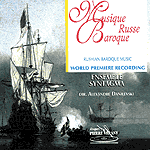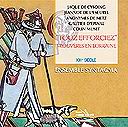
| About us >> | artists >> | programmes >> | listen >> | presse review >> | news - links >> |
Russia, XVII-XVIII England, XVII Spain, XV Italy, ca 1500 France, XIII-XIV

      |
UPDATE WILL COME SOON |
![]()

See alsoNews and Listen
Though not eastern, the original russian baroc from 1690 - 1740 is
totally ignored by the history of "european" music. It preceeds the great russian
baroc, and is the first manifestation of the secular author music in Russia.
These vocal miniatures were performed in concerts at the Imperial Court or in family parties.They are almost all anonimous. The texts are often inspired by the Bible, but the interpretation is quite free. The "vanity of vanity" is the most frequent theme.The singing was accompanied on all available instruments.
One of the earliest illustration of western influence on russian mode of life and art, these songs merge archaic cadences, closely bound with old polyphony and popular singing, with the western harmonic system.
This music creates an admirable picture of that is defined as the "russian soul" with its melancholy, sagacity, spirituality, idealism and maximalism, thoroughly imbued with the Quohelet's spirit.
Return to top
![]()
![]()
This programme includes songs by John Coperario, one of the summits of English music, and songs by his contemporaries.
The Elisabethain English song will remain one of the greatest events in musical history. It created a new form, where music and poetry are closely interwoven. The Coperario's songs are a quintessence of noble English style. his innovations are numerous, and he created also the first cycle of songs in history.
His authority was eminently high. He educated a Pleiad of composers of XVIIth century.
Return to top
![]()
This Franciscain monk is one of the first known
composer in Spain Renaissance. He works at the court of Alfonso Magnanimous,
King of Naple and of the Sicily, and at the court of his successor,
the King Ferdinando. ![]()
Now only 11 songs,
1 missa and 1 motet by Cornago are known.
The particularity of these compositions are that they are all
the greatest masterpieces.
Cornago's songs are inspired by italian and courteous poetry.
Their style evoques the years he had spent in Italy.
In his music the Italian grace and the Spanisch impassioned melodic outlines
join the Netherlandisch polyphony.
The eleven songs included in our programme are performed in accordance
with the practice of that time and as conceived by the composer -
with instrumental gloses and diminutions, each one with its own particular
caracter.
Return to top
![]()
![]()
The italian music around 1500 was a fascinating melting-point where the creative forces of all Europe were mixing. In the preceeding centuries there were the Netherlands and the Burgundy that had dominated the musical landscape; since 1500 it was the Italy that was at the head of musical development. The princely courts and the cities emulated each others in splendour and in welcoming the artists who went in Italy banished by political and economic changes in nothern Europe.
The Flamish influences and the italian ones merged, and the european music was transfigured by the Italian genious, who provided it with its beautiful language, its expressive and simple melodies and recitative art.
Return to top
 Songs by Gautier d'Epinal, Colin Muset and anonymous; among these last ones; the only 4 motets survived the fire during the second world war from the Manuscript of Metz.
Songs by Gautier d'Epinal, Colin Muset and anonymous; among these last ones; the only 4 motets survived the fire during the second world war from the Manuscript of Metz.
The knight Gautier, said d'Epinal, was and continue to be considered (by a few connoiseurs now) as one of the best trouveres. He has been mostly famous for his chansons d'amour where he showed an extraordinary, highly inventive talent for creating new melodies.
Colin Muset was a master of "cirventes", musical pamphlets especially tipical for Lorraine. With commended fortitude and humor, in limpid melodic outlines, he narrates about his good and (more frequently) bad lucks of professional itinerant musician and composer, perpetually hanting for patrons.
Anonymous. In Middle Ages music circulated almost as easily as today, some melodies became an obligatory part of repertoire, and were played all aver the Europe in very free way. these pieces recreate the natural environment of our composers.
Return to top
![]()
| About us >> | artists >> | programmes >> | listen >> | presse review >> | news - links >> |